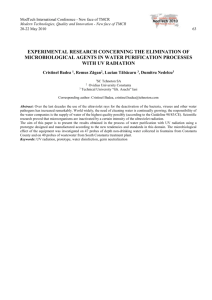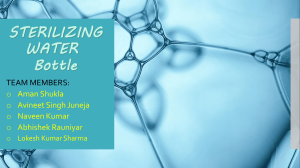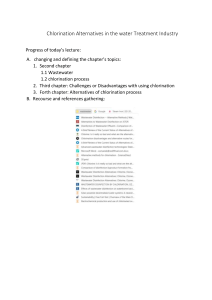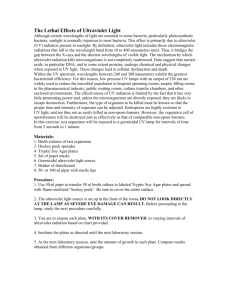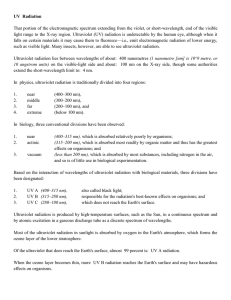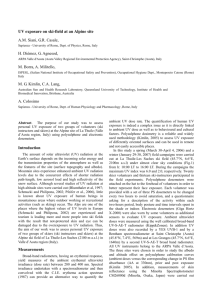PDR Report
advertisement
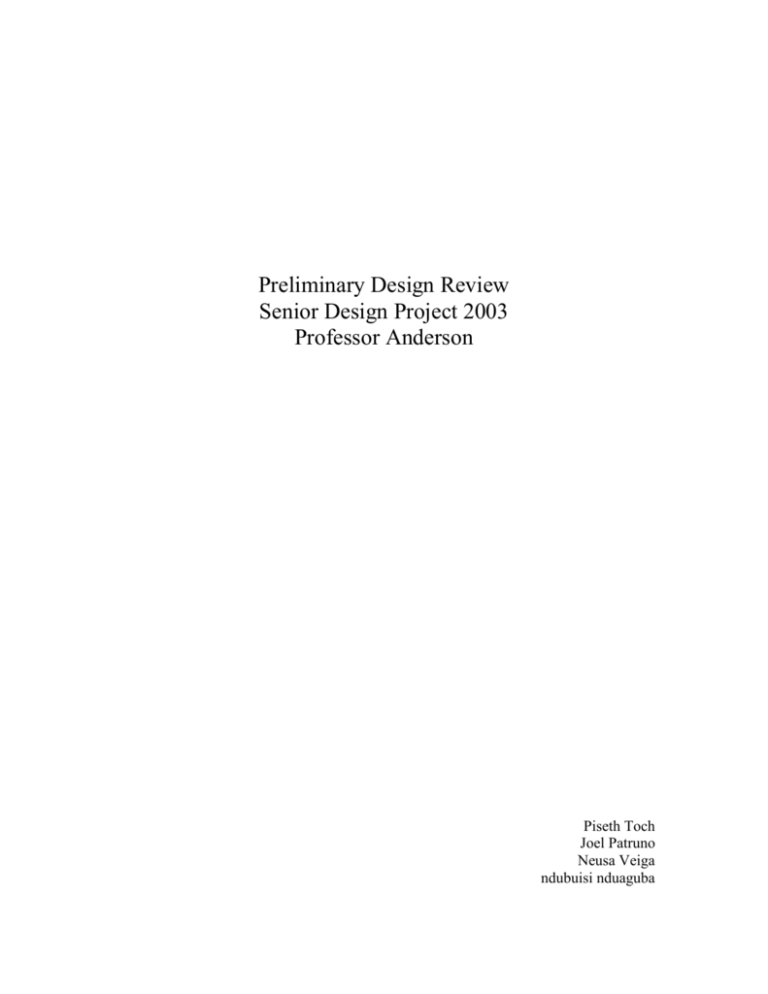
Preliminary Design Review Senior Design Project 2003 Professor Anderson Piseth Toch Joel Patruno Neusa Veiga ndubuisi nduaguba Many of us today are not aware of a major problem that plagues people around the world. We Americans have such a readily accessible source of clean water that we take it for granted. Many third world countries have little or no access to clean drinkable water which leads to high infant mortality rates and lower life expectancies. In many cases, purification of water is unattainable because there simply is not a source of energy or many manual purification techniques are just too expensive. The goal of our project is to produce a water purification system that uses the energy from the sun to implement proven techniques which can reduce and eliminate dangerous microorganisms and viruses. We plan to develop a system such that we can purify one gallon of water in one day. This sounds like a small amount of water however this model can be scaled up to produce hundreds of gallons a day, which is enough for a family to survive and perform everyday activities. There are a myriad of ways to disinfect water. Some of which are better than others. The easiest and most common way to treat water is to simply boil it. However this requires a heat source and expends a lot of energy. This technique also produces a limited amount of water depending on how it is scaled. Also, we could have a large tank of water but it would take forever to heat up, and we could have small amounts of water but that would take also a long time to produce the same amount of water. Another way to disinfect water is to use chemicals such as iodine or chlorine through a process known as chlorination. The main advantage chlorination is that mass amounts of water can be treated for a very little amount of money. This is of course assuming you have the proper equipment and infrastructure to support the process, which can be a disadvantage. This is why Americans have good access to clean water. Poor countries on the other hand are not able to treat their water in the fashion we do. Another disadvantage to chlorination is that it changes the chemical composition of the water and leaves a taste to the water. If chlorination isn’t done properly it can actually become dangerous to those drinking it. The latest technique in water purification is ultraviolet radiation. By exposing bacteria and viruses to a simple UV light we can kill them or modify their DNA enough to the point that they become harmless. The advantage to UV radiation is that it is not an extremely difficult technique to implement. The process can sanitize water in mass amounts and overexposure does not change the water, leaving it safe for consumption. The disadvantage to UV radiation, however, is that if the water isn’t used within a few days some bacteria that haven’t been killed may regenerate and infect the water again. Also UV radiation only works in a specific range of UV wavelengths, those being between 230nm and 280nm. Only germicidal mercury lamps can effectively produce these wavelengths. These lamps themselves have to be treated with care because they can pollute the environment. Ultraviolet radiation becomes ineffective if the water is turbid. The bacteria and microorganisms, many on the scale of microns, can hide behind the much larger particulate in the water and actually dodge the UV rays. Our idea is to implement a system where we can utilize at least two techniques of water purification which makes the system efficient, easy to use, and most importantly produces clean drinkable water. Our current strategy is to implement physical filtration and further disinfect with UV radiation. Plans to use chemical disinfection are also still up in the air. Our main plan of action is to use a sun tracking solar panel from last years design project to provide power to an ultraviolet light. Stages before UV radiation include a prefiltering process using physical filters to remove turbidity and improve ultraviolet effectiveness. From there we have to create a control system which ensures proper exposure to the UV light. Once we have clean water we need to ensure there is no cross contamination of clean water with dirty water. This all has to be done with a limited source of power because the solar panel generates about 1.9 amp hours during an eight hour period of full sun exposure. The system therefore has to be extremely efficient and self balancing meaning the amount of power available has to be proportional to the amount of clean water that can be produced. Attached is a preliminary diagram of our anticipated design. To review, our product specifications are as follows: - The system must be standalone where the user can introduce water, from a river for example, and simply walk away. The system utilizes only solar power. The system must produce one (1) gallon of water during an eight hour period of sunlight. The system must be designed with low maintenance in mind. The system must prevent cross contamination. The system must use its power wisely so as to not use more power than available. The system must have target maintenance free period of 2 years.
